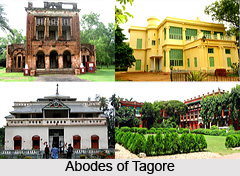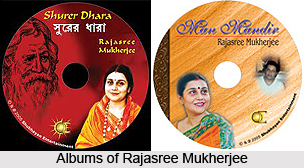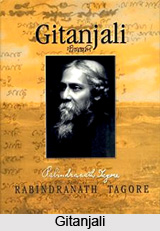 Rabindranath Tagore, a renowned poet and a Nobel award receiver for literature, was born in the year 1861. He grew up in the heart of Kolkata in a colonised country. Tagore`s works focused on certain issues such as racial humiliation, search for self-esteem, education, and religion that was concerned with India. Two songs from his Rabindra Sangeet canon are now the national anthems of Bangladesh and India, `Amar Shonar Bangla` and `Jana Gana Mana` respectively. Tagore was also a cultural reformer and polymath who modernised Bengali art by rejecting strictures, binding it to classical Indian forms. Literary works, nationalism and Santiniketan remained the passion of Tagore, for more than six decades of his life. Tagore breathed his last in the year 1941.
Rabindranath Tagore, a renowned poet and a Nobel award receiver for literature, was born in the year 1861. He grew up in the heart of Kolkata in a colonised country. Tagore`s works focused on certain issues such as racial humiliation, search for self-esteem, education, and religion that was concerned with India. Two songs from his Rabindra Sangeet canon are now the national anthems of Bangladesh and India, `Amar Shonar Bangla` and `Jana Gana Mana` respectively. Tagore was also a cultural reformer and polymath who modernised Bengali art by rejecting strictures, binding it to classical Indian forms. Literary works, nationalism and Santiniketan remained the passion of Tagore, for more than six decades of his life. Tagore breathed his last in the year 1941.
Early Life of Rabindranath Tagore
Tagore was born the youngest of fourteen children, in the Jorasanko mansion, now known as Tagore House, to parents Debendranath Tagore and Sarada Devi. Rabindranath Tagore was born in a family that could easily be passed off as one of the leading Indian merchants. The Tagores` were a cultured and wealthy family, and Rabindranath`s father, Debendranath, was one of the leaders of the Brahmo Samaj. Rabindranath Tagore was born in an atmosphere of the advent of new Bengali ideals. Rabindranath`s progressive views and ideals can be attributed to his family`s belief in synthesis of old and new influences. The poet`s early life was spent in an atmosphere of religion and arts, principally literature, music and painting. Tagore`s philosophies and way of living was heavily influenced by the concepts of Vedas and Upanishads. In music Tagore`s training was classical Indian, though as a composer, he rebelled against the tyranny of classical orthodoxy, and introduced many variations of form and phrase, notably from Bengali folk music of the Baul and Bhatiyali type.
 Rabindranath wrote his first poem at the age of six and as a young boy studied the classical poetry of Kalidasa. He also studied the Upanishads, languages and modern sciences. He did his basic education at home. His home schooling, life in Shilaidaha, and travels made Tagore a nonconformist and pragmatist. However seeking to become a barrister, Tagore enrolled at a public school in Brighton, England in 1878; later, he studied at University College London, but returned to Bengal in 1880 without a degree.
Rabindranath wrote his first poem at the age of six and as a young boy studied the classical poetry of Kalidasa. He also studied the Upanishads, languages and modern sciences. He did his basic education at home. His home schooling, life in Shilaidaha, and travels made Tagore a nonconformist and pragmatist. However seeking to become a barrister, Tagore enrolled at a public school in Brighton, England in 1878; later, he studied at University College London, but returned to Bengal in 1880 without a degree.
Achievements of Rabindranath Tagore
Rabindranath`s earlier works reflected his belief in his own country and in a culture of universal humanity transcending all barriers of time and place. He published his first substantial poetry-under the pseudonym Bhanushingho (Sun Lion), in 1877 and wrote his first short stories and dramas at age sixteen. This self-expression of Rabindranath Tagore became apparent especially during 1878-80. This was the period when the national movement coincided with the neo-Hindu revival in Bengal. If on one level he criticised the caste system and rituals through his poems and writings, then on the other level he tried to justify its existence. During the Swadeshi Movement, Rabindranath wrote several books, articles, poems and songs about Bengal that created a patriotic fervour.
Some of his famous works at that time included an essay called `Swadeshi Samaj` and a famous novel called `Gora` and short stories like `Kabuli Walla`. Rabindranath pointed out that his brothers set a bold example by strongly advocating Bengali literature at a time when the educated men began to keep at arms length both the language and the thought of their native land. It can hence be noted that his brothers were the inspiration for Rabindranath at the onset of his literary career.
Rabindranath as a Poet
Rabindranath Tagore was known for his different forms of creative writing such as essays, letters, short stories, novels and dramas and is best known for his poems. Among his fifty and odd volumes of poetry are Manasi (1890), Sonar Tari (1894), Gitanjali (1910), Gitimalya (1914), and Balaka (1916). The English renderings of his poetry, which include The Gardener (1913), Fruit-Gathering (1916), and The Fugitive (1921), do not generally correspond to particular volumes in the original Bengali; and in spite of its title, Gitanjali: Song Offerings (1912), the most acclaimed of them, contains poems from other works besides its namesake. Tagore`s major plays are Raja (1910), Dakghar (1912), Achalayatan (1912), Muktadhara (1922), and Raktakaravi (1926).
 His poems reflected his beliefs and his feelings, be it of protest against misconduct or of support for a humanitarian cause. Tagore`s poetry was influenced by traditional Indian poetry. For example, the devotional Indian poets of Ramprasad and Kabir especially influenced his early poetry works. Later he was influenced by the Baul tradition, which is a tradition of traditional Bengali folk music, known for its simple ballads and invocation to union with the beloved. He also won a Nobel Prize for his poetic work of Gitanjali.
His poems reflected his beliefs and his feelings, be it of protest against misconduct or of support for a humanitarian cause. Tagore`s poetry was influenced by traditional Indian poetry. For example, the devotional Indian poets of Ramprasad and Kabir especially influenced his early poetry works. Later he was influenced by the Baul tradition, which is a tradition of traditional Bengali folk music, known for its simple ballads and invocation to union with the beloved. He also won a Nobel Prize for his poetic work of Gitanjali.
Rabindranath and Santiniketan
By 1863, Rabindranath turned his attention to the Santiniketan School after withdrawing from the Swadeshi movement. Later on, Rabindranath established the Santiniketan School in his father`s ashram in 1901. He hoped to give life to the concepts of the Upanishads in his Santiniketan institution. Rabindranath Tagore was convinced that all human problems such as poverty, religious discord, and disunity would find their resolution in education. The arrangements at Santiniketan were extremely primitive. Though he valued the primitive nature of Santiniketan, his ideal school had to do much more than that. In the year 1918, Rabindranath Tagore established Santiniketan College, which later on, in 1926, had to be affiliated to University of Calcutta. Step by step Santiniketan moved from being a collection of separate educational experiments into an integrated body.
Nobel Prize and Rabindranath Tagore
With the combined efforts of both Rothenstein and W.B. Yeats, who were tremendously impressed by Tagore`s Gitanjali, a private edition of the English Gitanjali was published through the Indian Society of London. Even before the Nobel Prize was announced, Gitanjali became widely accepted all over. Finally the news of the Nobel Prize reached him on 13th November 1913. In the summer of 1912, Rabindranath took to England some translations of his favourite poems. The Nobel Prize for Literature brought Tagore into the public eye in both the East and West. He later on often travelled to the U.S and Europe to share his poetry and raise funds for his own ashram.

After winning the award, there was a great demand for his work in English. In response to that demand he put together more and more translations of his writings. Tagore was also awarded the knighthood in 1915, but he surrendered it in 1919 as a protest against the Massacre of Amritsar, where British troops killed some 400 Indian demonstrators protesting colonial laws.
Later Years and Death of Rabindranath
In his later years, Tagore suffered from persistent pain and subsequent periods of sickness. He even suffered from coma during 1937. The poetry written by Tagore in these twilight years are unique for their obsession with death; these more profound and mystical experimentations allowed Tagore to be branded a modern poet. Rabindranath Tagore died on August 7th 1941 in his Jorasanko mansion, at the age of 80.
Even after his death, Rabindranath Tagore remained a towering figure in the millennium-old literature of Bengal. His poetry as well as his novels, short stories, and essays are very widely read, and the songs he composed reverberate around the eastern part of India and throughout Bangladesh.













